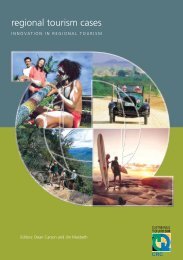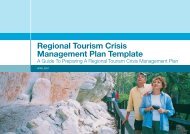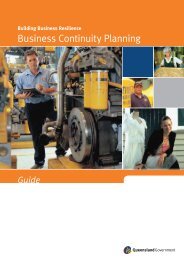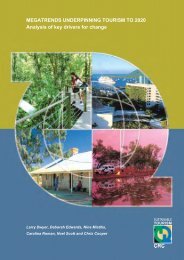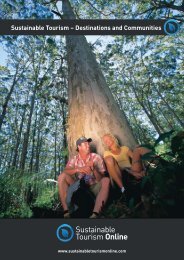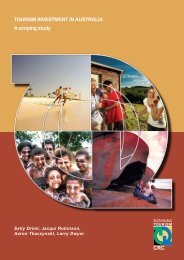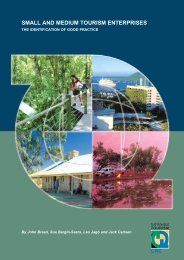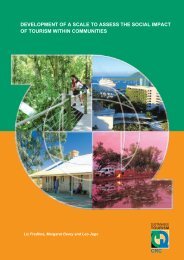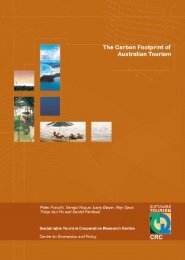Tourism Risk Management - Sustainable Tourism Online
Tourism Risk Management - Sustainable Tourism Online
Tourism Risk Management - Sustainable Tourism Online
Create successful ePaper yourself
Turn your PDF publications into a flip-book with our unique Google optimized e-Paper software.
visitor spots, resort managers reported a slew of cancellations. El Nido resort in northern Palawan<br />
had about a 15% cancellation rate (Hookway, 2001). Dos Palmas Island Resort, where Abu Sayyaf<br />
abducted 20 people in May 2001, had been closed since then for almost one year.<br />
Marketing Campaigns<br />
The tourism industry is one of the flagship industries under Philippine President Gloria Macapagal-<br />
Arroyo. A series of marketing campaigns has been launched in order to attract more visitors to the<br />
Philippines.<br />
Due to the instability and travel advisories focusing on the southern Philippines, President Arroyo<br />
has outlined a viable strategy to transform North Philippines and Aurora province into the country’s<br />
next premier investment and tourism destinations. A marketing campaign labelled “WOW<br />
Philippines!” has been launched by the DOT. WOW is the master acronym for Wealth of Wonders<br />
which reflects the country’s diverse offerings in tourism attractions (Department of <strong>Tourism</strong>, n.d.).<br />
The tourism promotions blitz covers three continents, including North America, Asia and Europe.<br />
<strong>Tourism</strong> Secretary Richard Gordon led a strong Philippine contingent with no less than fifty<br />
companies participating, in each leg of the road shows. The group comprised local government<br />
officials, travel trade and major supporters such as Philippine Airlines, Singapore and WG&A Super<br />
Ferry. The road shows and sales missions aimed to intensify marketing efforts for the country’s<br />
major target markets and, in particular, to launch “Visit Philippines 2003”, which was fully endorsed<br />
by the World <strong>Tourism</strong> Organization (UNWTO) (Paez, n.d.). With its target of drawing three million<br />
visitors, VPY 2003 seeks to promote the Philippines as a unique and multifaceted business and<br />
travel destination. It also aims to instil in every Filipino a sense of pride towards the country and its<br />
people (Umali, n.d.).<br />
Performance of the Philippine tourism industry has improved significantly since 2002 despite travel<br />
advisories from various countries and the continuous threat of terrorism. One reason for the<br />
success is that President Arroyo has been addressing the terrorist threat in the Philippines. Another<br />
critical reason lies in the aggressive tourism marketing and promotions to fuel tourism growth. It<br />
shows that in spite of the extent of crisis, visitor confidence can be rebuilt by the effort of the<br />
government in addressing the problem and by an effective marketing campaign.<br />
Enhancement of Security<br />
After the kidnapping by Abu Sayyaf in May 2001, police have bolstered security around popular<br />
resorts as part of Manila’s effort to rid the archipelago of its image as an unsafe visitor destination.<br />
<strong>Tourism</strong> Secretary Richard Gordon also pledged to deploy an extra 1,000 police officers at key<br />
visitor spots (Coleman, 2002). In the wake of the Korean diplomat’s killing in June 2002, police set<br />
up a special force of 1,700 men to protect embassies and other key foreign establishments in<br />
Manila (Madhur, 2002). Both private and public sectors in the Philippines undertook heightened<br />
security measures to protect visitors. For example, Dos Palmas Island Resort, where a mass<br />
kidnapping happened in May 2001, added security nets to control sea access to the resort. The<br />
Philippines government also expanded security measures in major airports and seaports to assure<br />
the safety of foreigners in the country.<br />
Government Policy and Actions against Terrorist Group<br />
The Philippine government policy towards abduction is that there will be no negotiation for any kind<br />
of ransom. However, the government has allowed the payment of ransom from members of<br />
hostages’ families.<br />
There has been constant military pressure on Abu Sayyaf since August 2000. In September,<br />
President Estrada ordered the Armed Forces of the Philippines (AFP) to commit over 1,500 troops<br />
into Jolo to conduct operations against Abu Sayyaf units that had taken foreign hostages in<br />
Malaysia. In the following year, President Arroyo ordered the AFP to deploy as many as 4,500<br />
troops into Basilan after the hostage-taking on Palawan. The government also offered a $2 million<br />
84 <strong>Tourism</strong> <strong>Risk</strong> <strong>Management</strong> – An Authoritative Guide to Managing Crises in <strong>Tourism</strong>



